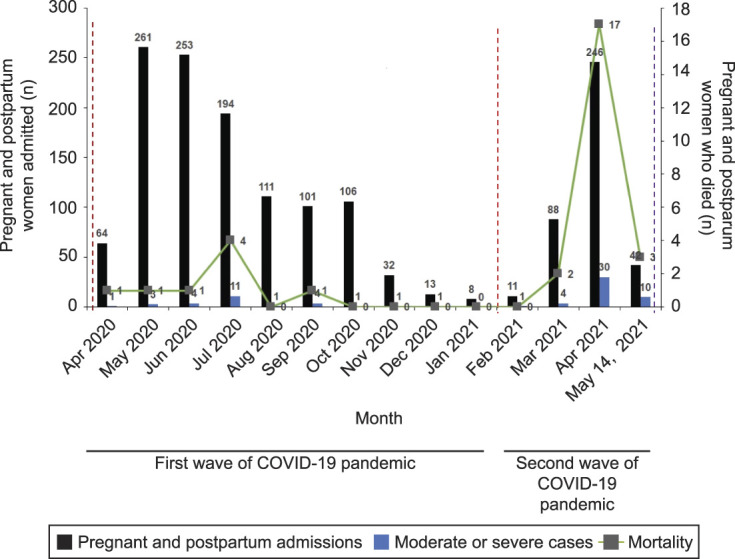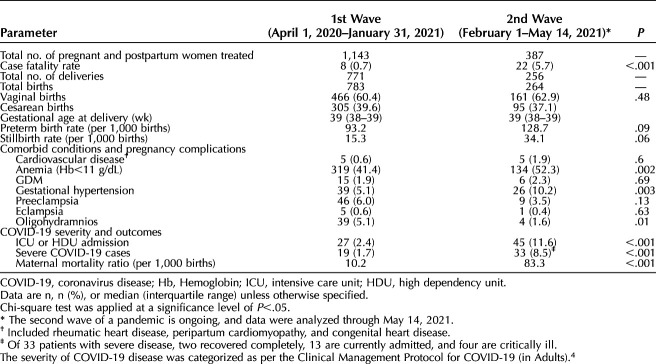Abstract
Rates of severe coronavirus disease 2019 (COVID-19), intensive care unit admission, and maternal mortality increased among pregnant and postpartum women admitted for COVID-19 in the second wave compared with the first wave in India.
INTRODUCTION
The second wave of the coronavirus disease 2019 (COVID-19) pandemic is ongoing in India, contributing to a total of more than 25 million cases and nearly 0.3 million deaths as of May 19, 2021.1 We aimed to evaluate differences in clinical presentation, comorbidities, pregnancy complications, and outcomes in women with COVID-19 during the first and ongoing second wave of the COVID-19 pandemic in India.
METHODS
We performed a retrospective observational cohort study of pregnant and postpartum women with COVID-19 admitted at BYL Nair Charitable Hospital, a dedicated COVID-19 tertiary care hospital in the Mumbai Metropolitan Region. COVID-19 was diagnosed as per the national testing guidelines.2 Pregnant women with confirmed COVID-19 who were near-term and those who needed obstetric interventions, those with high-risk pregnancies, and pregnant and postpartum women (up to 6 weeks) with moderate or severe disease were admitted after screening at a special screening outpatient department3 during both waves of COVID-19. Pregnancy outcomes and COVID-19 severity were compared between women admitted during the first and second waves of the COVID-19 pandemic in India (Fig. 1). The severity of COVID-19 was categorized as per the Clinical Management Protocol for COVID-19 (in Adults).4 Univariable comparisons were made using χ2. P<.05 was considered statistically significant. Statistical analysis was performed using SPSS Statistics Base 26.0.
Fig. 1. Timelines of the first and second waves of coronavirus disease 2019 (COVID-19) in India. Mahajan. Pregnancy and Second Wave of COVID-19. Obstet Gynecol 2021.

.
The study was approved by the Ethics Committees of TNMC (No. ECARP/2020/63 dated May 27, 2020) and ICMR-NIRRH (IEC no. D/ICEC/Sci-53/55/2020 dated June 4, 2020). The study is registered with the Clinical Trial Registry of India (Registration no: CTRI/2020/05/025423).
RESULTS
A total of 1,530 pregnant and postpartum women were admitted as per the admission policy3 during the first (n=1,143) and second waves (n=387) of the COVID-19 pandemic. The rates of severe COVID-19, admission to the intensive care unit or high dependency unit, case fatality rate, and maternal mortality ratio were higher during the second wave (Table 1). The preterm birth rate and stillbirth rate were not statistically different (Table 1).
Table 1.
Comparison of Pregnant Women With Coronavirus Disease 2019 (COVID-19) Admitted at BYL Nair Charitable Hospital in Mumbai During the First and Second Waves of the COVID-19 Pandemic in India
The majority of maternal deaths (93%, 28/30) were due to COVID-19 pneumonia and respiratory failure. Descriptive characteristics for maternal deaths are included in Appendix 1, available online at http://links.lww.com/AOG/C368. No statistical differences were found in baseline characteristics or clinical presentation between deaths in the first and second waves, possibly due to low sample size.
DISCUSSION
Our study demonstrates a higher frequency of severe COVID-19, intensive care unit or high dependency unit admission, and maternal deaths during the second wave of the COVID-19 pandemic in India. This is in line with a study from the United Kingdom that reports higher frequency of severe COVID-195 but is in contrast to a study reporting low severity of COVID-19 during the second wave in Spain.6
Although the exact causes of the increase in severity and mortality are largely unknown, we suspect that a highly virulent variant of concern (B.1.6177–10), which is now considered responsible for the second wave in Maharashtra and other parts of India, played a role. However, genome sequencing data to show the direct association of B.1.617 leading to adverse outcomes are not available, so definitive conclusions regarding the effect of the B.1.617 variant cannot be made. In addition, our data are limited to a single center. It is possible that higher case rates and delays in seeking health care are contributors to increased mortality during the second wave of the COVID-19 pandemic. It is, however, unlikely that less severely ill patients presented to other facilities in the region given the declaration of our facility as a dedicated COVID-19 hospital with standardized regional screening processes for admission across both waves of the pandemic. The findings of our study suggest the importance of offering vaccination to pregnant and lactating women during the ongoing COVID-19 pandemic.
Footnotes
The study is funded by an intramural grant of ICMR-NIRRH (ICMR-NIRRH/RA/1066/05-2021). Rahul K Gajbhiye is an awardee of the DBT Wellcome India Alliance Clinical and Public Health Intermediate Fellowship (grant no. IA/CPHI/18/1/503933).
Financial Disclosure The authors did not report any potential conflicts of interest.
Each author has confirmed compliance with the journal's requirements for authorship.
Published online ahead-of-print July 7, 2021.
Peer reviews and author correspondence are available at http://links.lww.com/AOG/C369.
Contributor Information
Madhura Pophalkar, Email: vidhyesh.madhura@gmail.com.
Sarika Patil, Email: sarikapatil12@rediffmail.com.
Bhagyashree Yewale, Email: greendoctor18@gmail.com.
Itta Krishna Chaaithanya, Email: chaitanyaitta@gmail.com.
Smita D. Mahale, Email: smitamahale@hotmail.com.
REFERENCES
- 1.Government of India, Ministry of Health and Family Welfare. COVID-19. Accessed May 19, 2021. https://www.mohfw.gov.in/ [Google Scholar]
- 2.Indian Council of Medical Research. National testing strategy for COVID-19. Accessed June 24, 2021. https://www.icmr.gov.in/cteststrat.html [Google Scholar]
- 3.Mahajan NN, Pednekar R, Patil SR, Subramanyam AA, Rathi S, Malik S, et al. Preparedness, administrative challenges for establishing obstetric services, and experience of delivering over 400 women at a tertiary care COVID-19 hospital in India. Int J Gynaecol Obstet 2020;151:188–96. doi: 10.1002/ijgo.13338 [DOI] [PMC free article] [PubMed] [Google Scholar]
- 4.Government of India, Ministry of Health and Family Welfare. Clinical management protocol for COVID-19 (in adults). Accessed June 24, 2021. https://www.mohfw.gov.in/pdf/UpdatedDetailedClinicalManagementProtocolforCOVID19adultsdated24052021.pdf [Google Scholar]
- 5.Kadiwar S, Smith JJ, Ledot S, Johnson M, Bianchi P, Singh N, et al. Were pregnant women more affected by COVID-19 in the second wave of the pandemic? Lancet 2021;397:1539–40. doi: 10.1016/S0140-6736(21)00716-9 [DOI] [PMC free article] [PubMed] [Google Scholar]
- 6.Iftimie S, López-Azcona AF, Vallverdú I, Hernández-Flix S, de Febrer G, et al. First and second waves of coronavirus disease-19: a comparative study in hospitalized patients in Reus, Spain. PLoS One 2021;16: e0248029. doi: 10.1371/journal.pone.0248029 [DOI] [PMC free article] [PubMed] [Google Scholar]
- 7.Cherian S, Potdar V, Jadhav S, Yadav P, Gupta N, Das M, et al. Convergent evolution of SARS-CoV-2 spike mutations, L452R, E484Q and P681R, in the second wave of COVID-19 in Maharashtra, India. bioRxiv 2021; 2021.04.22.440932. doi: 10.1101/2021.04.22.44093 [DOI] [PMC free article] [PubMed] [Google Scholar]
- 8.Hoffmann M, Hofmann-Winkler H, Krüger N, Kempf A, Nehlmeier I, Graichen L, et al. SARS-CoV-2 variant B.1.617 is resistant to Bamlanivimab and evades antibodies induced by infection and vaccination. bioRxiv 2021.05.04.442663. doi: 10.1101/2021.05.04.442663 [DOI] [PMC free article] [PubMed] [Google Scholar]
- 9.Dhar MS, Marwal R, Radhakrishnan V, Ponnusamy K, Jolly B, Bhoyar R, et al. Genomic characterization and epidemiology of an emerging SARS-CoV-2 variant in Delhi, India. medRxiv 2021:2021.06.02.21258076. doi: 10.1101/2021.06.02.21258076 [DOI] [PMC free article] [PubMed] [Google Scholar]
- 10.Wall EC, Wu M, Harvey R, Kelly G, Warchal S, Sawyer C, et al. Neutralising antibody activity against SARS-CoV-2 VOCs B.1.617.2 and B.1.351 by BNT162b2 vaccination. Lancet 2021;397:2331–3. doi: 10.1016/S0140-6736(21)01290-3 [DOI] [PMC free article] [PubMed] [Google Scholar]



